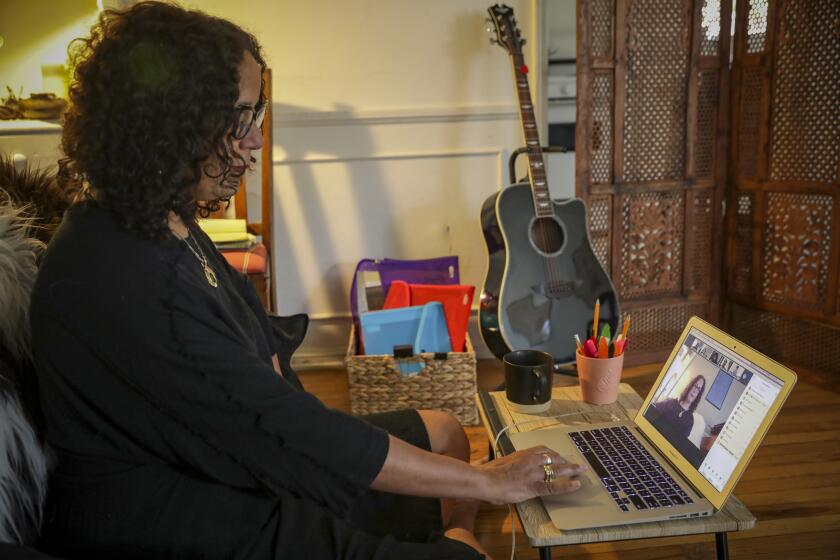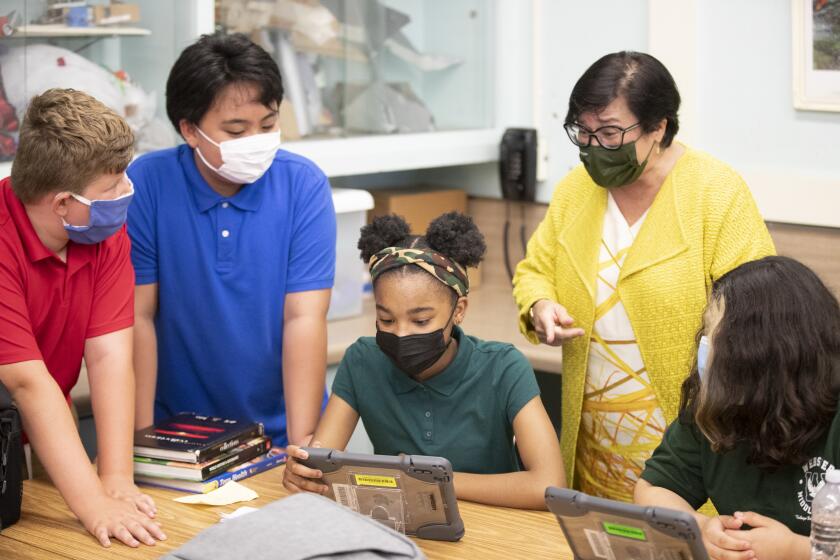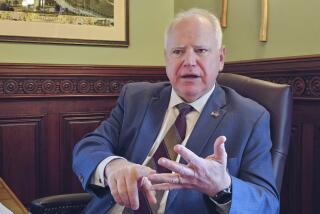Column: A demeaning teacher scramble for cash is a symbol of what’s wrong with education funding

- Share via
The first-ever Dash for Cash event pitted 10 Sioux Falls area teachers against each other to grab as many single dollar bills as possible in less than five minutes. The money, meant to go toward either their classroom or school, was donated by CU Mortgage Direct.
— Sioux Falls, S.D., Argus-Leader
It wasn’t a joke.
It wasn’t a parody, nor a satire, nor performance art.
It was an honest-to-God scramble for cash, foisted on teachers in South Dakota, where salaries are among the lowest in the nation. They average less than $50,000 a year.
The money grab was the entertainment between periods for Saturday’s Sioux Falls Stampede hockey game.
In a video that (inevitably) went viral on Twitter, public school teachers in jeans, T-shirts and helmets knelt on a shag rug tossed onto the ice and scooped up $1 bills that had been dumped onto the rug. Five grand was on the line. The teachers stuffed the money down their shirts as fast as they could.
Some critics compared the exercise to the 2021 Korean-language survival drama “Squid Game” — in which characters desperate for money enter a deadly competition — without the blood. It put me in mind of the 1969 satirical movie “The Magic Christian,” without the manure.
In reality, it wasn’t either of those things.
The goal in “Squid Game” was to stay alive. The goal in “The Magic Christian,” the film starring Peter Sellers and Ringo Starr, was to show how people will compromise or debase themselves for money. (Its famous final scene showed proper gentlemen in bowler hats and suits diving after cash into an excrement-filled vat.)
But the teachers in the ice-cold hockey arena were not in it for themselves; they were scrambling for entirely altruistic reasons. They want better for the kids in their classrooms.
“The teachers in this area, and any teacher, they deserve whatever the heck they get,” said the marketing director for the mortgage company that dreamed up this unintentional exercise in humiliation.
I know he meant well, but as the child of a Los Angeles Unified School District teacher who spent far too much of her own cash on classroom supplies, it was hard not to read his quote as an insult. Most teachers deserve so much more than what they get. When she died at 70 in 1998, my mother, who taught deaf and hard-of-hearing students, left a trove of teaching supplies.
“This just feels demeaning,” tweeted Randi Weingarten, president of the American Federation of Teachers. “No doubt people probably intended it to be fun, but from the outside it feels terrible.”
The hockey team and the mortgage company later apologized.
Each weekday morning for 90 minutes, I was an involuntary hostage to my 10-year-old’s distance-learning class. I loved it.
I certainly don’t blame the South Dakota teachers who participated. They were hoping to get enough money, they told the Argus-Leader, to purchase flexible seating, such as standing desks, or computer and sports equipment.
Good luck with that. When the spectacle ended less than five minutes after it began, their cash hauls ranged from $378 to $616.
The stunt was in terrible taste, for sure, but it also encapsulated in one sickening moment much of what is awry with how we fund (or don’t fund) public education, and the regard in which we hold teachers in this country, most of whom are women. (Women account for 80% of elementary and middle school teachers.)
Even the federal government has formalized the practice of teachers’ reaching into their own pockets to help students. The IRS allows qualified teachers to deduct up to $250 in classroom supplies each year, but as many teachers have noted, that amount is a pittance compared with how much they actually spend.
Last year, the Washington Post surveyed American teachers to get a sense of how much of their personal funds are spent on supplies. The paper heard back not just from public school teachers but teachers in private, parochial and charter schools.
“The portrait that emerges is devastating — and reveals that the problem has existed, without remedy, for decades,” wrote education reporter Valerie Strauss. “It has gotten worse over time.”
From a North Carolina teacher: “We are not allowed to ‘ask’ from the community. So, essentially, I buy my own supplies.”
A Minnesota educator: “Not sure what you need this information for, but teachers are funding their classrooms, not school districts.”
Teachers said they buy all manner of traditional classroom supplies and also — incredibly — even furniture.
“There’s a joke that, in most professions,” wrote a Massachusetts teacher, “you steal office supplies from work to bring home, but teachers steal office supplies from home to bring to work.”
One teacher simply said, “I am a scavenger.”
As we navigated a rite of passage, she worried about her new locker. I worried about COVID-19.
COVID-19 has only made things worse. Last year, the HuffPost reported that Los Angeles science teacher Mishna Hernandez, who normally spends between $500 and $700 on supplies, estimated that she spent at least $3,000 to prepare for online teaching from home, including purchasing an iPad, an iMac and a desk.
Online, it’s become popular for teachers to post wish lists on Amazon that are filled by everyday good Samaritans.
The nonprofit group AdoptAClassroom.org regularly asks teachers about their out-of-pocket classroom spending. Its most recent survey found that teachers spend an average of $750 a year. Thirty percent of the 5,400 teachers surveyed reported spending $1,000 or more on supplies.
Well, you might say, no one is forcing teachers to do so.
That’s just the point, isn’t it?
Most teachers do what they can — and must — to make sure their kids have what they need to succeed.
This practice has become education as usual. What a shame we’ve come to accept it.
More to Read
A cure for the common opinion
Get thought-provoking perspectives with our weekly newsletter.
You may occasionally receive promotional content from the Los Angeles Times.














